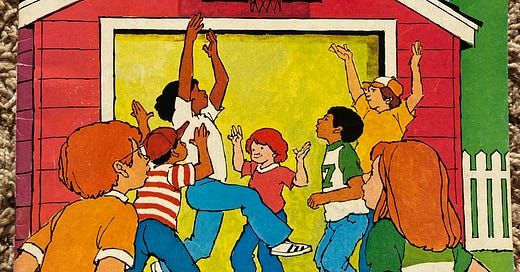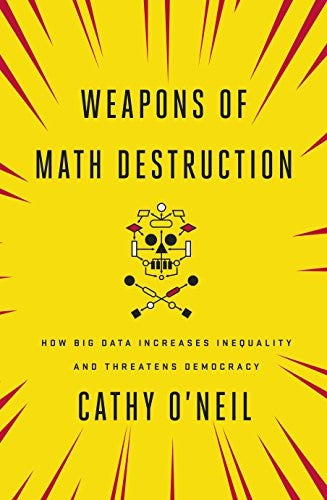This book of wholesome fun is dedicated to helping children grow—in basic skills and knowledge—in creativeness—in ability to think and reason—in sensitivity to others—in high ideals—and worthy ways of living—for CHILDREN are the world's most important people.
This passage is from the September 1984 inside cover of Highlights for Children: Fun with a Purpose magazine.
This monthly reader was pivotal to my childhood. Through Highlights, I got mail just for me on a monthly basis. When each issue arrived, I’d thumb through the pages and plan my reading experience.
As an early reader, I’d opt for reading The Timbertoes, Nursery School, and Goofus and Gallant, rather than the longer pieces. First on my list was the Hidden Pictures. With a marker in hand I’d circle all of the hidden objects. As my reading fluency advanced, I added the Riddles and Jokes sections to my list. I always loved the Things to Make segment—testing out my craft skills. The one regret I had about Highlights was never sending in my own creative piece to be featured in the Our Own Pages compilation, but I loved to see what other kids submitted.
Highlights was everywhere growing up. In addition to reading my own copies, I could read them at the pediatrician’s or dentist’s office. We had copies in the school library and the public library. In 42 pages, children across the country and even the globe had access to something made just for them.
Highlights is still around with several new magazines, learning and crafting packages, and even a subscription box.
A few months ago my mom sent me a few of my original copies and it got me thinking about creativity and the ways children find to express themselves.
During a recent review of a new literacy curriculum, I of course looked for signs of all of the typical literacy hallmarks. Does this curriculum provide high quality phonemic awareness, phonics, vocabulary, fluency, and comprehension instruction? Most of them do. But what I really look for is where the curriculum gives time for students to practice the skills they are learning and where it gives children room to make things.
This particular curriculum follows a traditional five day, six week cadence to each unit. In every unit, week six is a “Project-Based Inquiry.” This particular unit had the following project focus; I can research trees and the patterns in the tree bark, and I can write a fact sheet about the pattern the tree bark makes. Kinda boring sounding but there’s opportunity here. A skilled educator could take the “Customize It” sections, buried in the margins to the end of the week’s outline, and offer their students a wonderful creative experience.
While this curriculum does make an attempt at project-based learning, this is not the norm.
I went to EdReports, the leading curriculum evaluator, and searched through the highest rated literacy programs for indications of creativity in their design. What I found was rather stark. Zero programs evaluated by EdReports emphasized creativity in their product description. And, EdReports own evaluation tool does not have an indicator for creativity.
In a conversation with a friend and curriculum designer, she mentioned working on a project that integrates the America Succeeds’ Durable Skills into computer science instruction.
The report states “We cannot predict the future but we can help prepare students – every student – by equipping them with Durable Skills. We have an opportunity to transform career pathways for the benefit of students, employers, and communities by focusing on developing these common competencies in K-12 education.”
Not surprising, there is a quote from Kent Johnson, CEO of Highlights Magazine, in the ‘Business Perspectives on Durable Skills’ portion of the report.
“At Highlights for Children, we focus on helping children become their best selves. For 75 years, we have been dedicated to building a more optimistic and empathetic world where all children are curious, creative, confident and caring. Success in life comes from more than academic and technical skills. Our schools and communities succeed when they address the needs of the whole child. Children thrive when they develop social-emotional skills, when they build strength in communication, collaboration, and leadership, and when they exercise their curiosity, compassion, and empathy. Imagine a society where ALL children were able to fully develop such broad and durable skills.”
The report continues: “For this research we hypothesized that every job in every sector requires Durable Skills. America Succeeds partnered with Emsi Burning Glass to analyze over 82 million U.S. job postings from the past two years (2019-2020) to assess the prevalence of Durable Skills at both the national and state level.”
And wouldn’t you know it, creativity is among the top ten major competencies. To be employable in the future you must possess the following creative durable skills: innovation, creativity, creative problem-solving, creative thinking, imagination, visionary, ingenuity, ideation, experimentation, and brainstorming.
This begs my original question—If creativity is essential to employability, why don’t the products being marketed to schools include authentic opportunities to develop that competency?
I suspect the problem here is that creativity isn’t meant for all students.
Yep, you read that correctly. All students deserve a basic education but gifted students deserve more.
The National Association for Gifted Children Pre-K–Grade 12 Gifted Programming Standards references creativity eleven times, whereas, the Common Core State Standards for English Language Arts references this terminology twice.
The overlap between Gifted and Talented Education (GATE) and the expectations outlined in the Durable Skills report is a near circle.
As a kid in gifted programs and a teacher of kids who didn’t qualify, based on a set of subjective measures, I’ve alway wondered why the regular education didn’t look more like GATE. Let this be an opportunity to challenge curriculum publishers to reflect on the long term outcomes of their product’s implementation. Children are curious, adaptable, eager, inquisitive, observant, perceptive, imaginative, spontaneous, and energetic. They all deserve access to the best we can provide.
🔗All That and a Bag of Chips
Delight № 28 - Opting for herbs instead of ornamentals.
Delight № 29 - Launching season #1 of the No Opt-Out podcast.
Delight № 30 - Introducing old friends to new friends.
🔗Long Form
Read This
Weapons of Math Destruction: How Big Data Increases Inequality and Threatens Democracy by Cathy O'Neil
Free digital libraries
Libby App Thousands of public libraries offer ebooks and audiobooks (for free!) in Libby.
hoopla hoopla puts your public library at your fingertips. Anytime. Everywhere!
Used Books
ThriftBooks ThriftBooks sells millions of used books at the lowest everyday prices.
Also, check out your local thrift stores!





